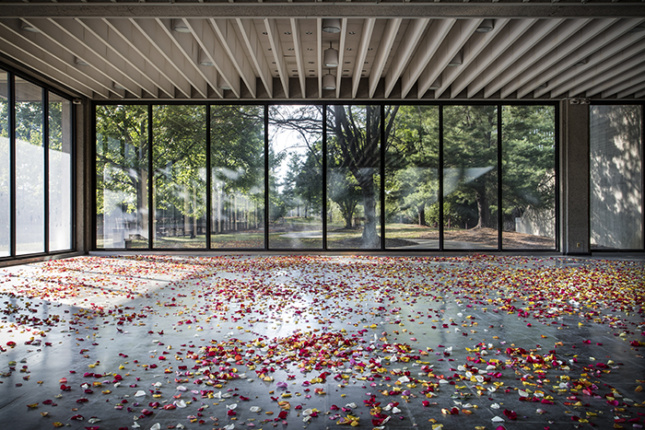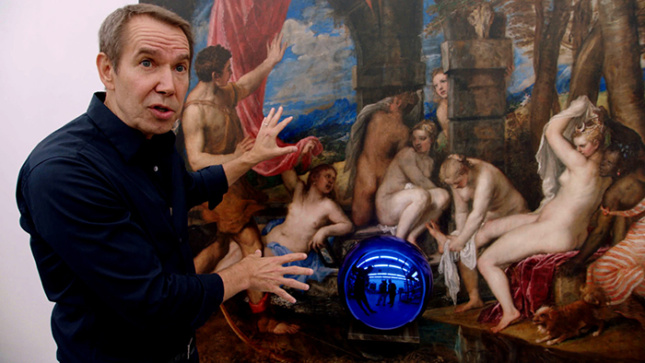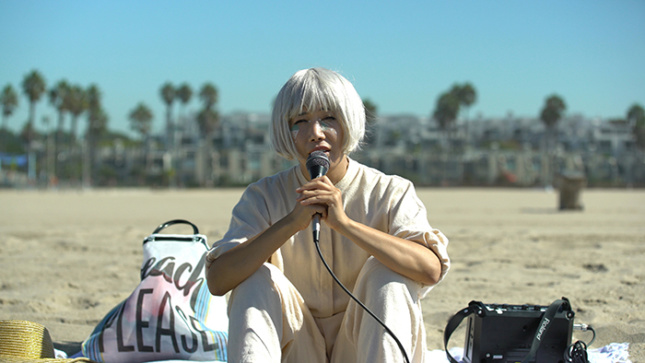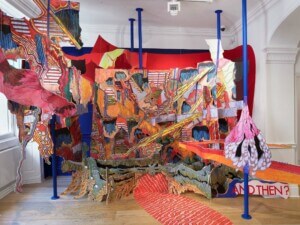The 2018 Sundance and Slamdance Film Festivals took place in Park City, Utah from January 18–28. The festivals featured a range of films exploring art and architecture—whether by profiling artists, addressing the relationship between buildings and memory, or exploring the value of art and architecture in the world, or the experiential possibilities of space.
“A house is a universe. It’s an entire world.” So says Alan Lightman, an MIT physicist in 306 Hollywood (2018), a film made by Elan and Jonathan Bogarín, a brother and sister, about their grandmother’s house after her death. Grandma Annette was a fashion designer and a self-proclaimed packrat. Her modest Newark house was piled with stuff, which their mother instructed them to toss. Defying the phrase, “Each time someone dies, a library burns,” the siblings decided instead to take an archeological expedition that turns the everyday objects they unearth into talismans. They arranged her stuff by color and typology into beautiful catalogues, made a 3-D model of the house, and pinned the dresses she designed onto the exterior of the house including the rooftop. The film tells the story of a life and a way to remember centered around the house and its objects.

The memory of a building is also the idea behind Sarah Meyohas’ Cloud of Petals (2017), which was shot at the former Bell Labs Holmdel Complex (now Bell Works), designed by Eero Saarinen in Holmdel, New Jersey. 10,000 hand-dissected rose petals were photographed and made into datasets, in homage to binary code pioneered at this facility. The filmmaker says “the bit of information was invented at Bell Labs….the transistor, the laser, and the very ones and zeroes of information theory.” In the film, this poetic activity enlivens the now ghost-like space.

One of the themes that emerged at the festival was value and success in art. The latest documentary by Nathaniel Kahn (My Architect (2003), The Price of Everything (2018), delves into the monetary value of art and how the market drives the art world. Interviews with representatives from auction houses, galleries, critics, curators, collectors, and artists explore this question. The inclusion of artist Larry Poons’s inclusion is notable. Poons, now 80, saw his work fall out of favor after garnering attention in the 1960s, but regardless, he has pressed on. Here, he is an articulate voice countering the marketplace as arbiter.

A different questioning of the art’s value occurs in a film set in 1989 Cuba. In Un Traductor [A Translator] (2018), the central character, Malin, a Russian literature professor at the University of Havana, is reassigned from his teaching post to a hospital to serve as a translator. 25,000 Chernobyl Nuclear Power Plant victims with radiation poisoning were sent to the hospital for medical treatment, and Malin is assigned to the pediatric ward. While at first resistant, he reluctantly comes around to the hospital work by reading the victims stories, and getting them to write and draw their experiences. Malin’s wife is a contemporary art curator preparing an exhibition. As he gets more involved with the kids’ life and death struggles, he become critical of her work, declaring, “It’s only art,” to which she responds that art is life. The value of art versus human life is a core question that upends this man’s life.

The Korean-American performance artist Vivian Bang, who co-wrote and stars in White Rabbit (2018), would agree. Her character went to art school, and now makes performances in supermarkets, parks and on the sidewalk about Koreans during the Los Angeles riots. She performs anywhere she can, because she must, despite the lack of any economic rewards.
In American Animals (2018), the value of art takes a criminal turn. A bored art student and his cohorts steal rare books which they try to sell to Christie’s. They are caught and sent to prison. Upon release, the protagonist makes his living drawing birds. The filmmakers intercut interviews with the actual perpetrators of the crime with the actors who portray them, making their plight more understandable as a reckless act of youth in a misguided quest for meaning and fast economic rewards.
Another tale gone awry is Arizona (2018), where the housing bust from the 2008 financial crisis wreaks havoc. A town outside Phoenix has multiple, nearly vacant gated communities with Spanish names, all including the word “d’oro,” or golden. A man tries to hang himself, a realtor is six mortgage payments behind, and a man about to foreclose takes out his frustration on his realtor. So begins a bloody hostage/murder spree in a desolate housing complex on an unfinished golf course. It’s an urgent, out-of-control romp through a land of dispiriting ghost towns.

Other films relished in the delight of art and artists, and the possibilities of new technologies. Two profiles of women artists stood out at the festival. Kusama – Infinity (2018) shows the 89-year-old Japanese artist Yayoi Kusama who is best known for Infinity Rooms and her fields of polka dots, and, according to the film, is now the most “successful” contemporary artist in the world. She is shown as a young, ambitious, obsessive artist whose pioneering work was eclipsed by male artists whose similar works were praised, while hers were ignored. Her early contact with Georgia O’Keefe, who helped with her move to the U.S., and Joseph Cornell is cited, as is her return to Japan in the 1970s where checked herself into a mental hospital where she continues to live, with a studio a short walk away. She opened a museum in Japan devoted to her work last year.

Impresario fashion designer Vivienne Westwood is shown as a classic artist, filled with energy, creativity, originality, and spunk in Westwood: Punk, Icon, Activist (2018).The excellent music choices—no punk included—mirror her designs.

In the short documentary, I’m Not Sure (2017), directed by Gabriel Hensche, surrealist paintings by René Magritte are verbally described by an app that amusingly scrambles the meaning. The titular phrase is vocalized whenever the app is stumped by such iconic works as The Treachery of Images (the famous “This is not a pipe” painting) and Time Transfixed (which depicrs a train chugging out of a fireplace). The “neural image caption generator” the filmmaker used was developed to provide automatic verbal descriptions for the blind.

Finally, at New Frontier, the Sundance section devoted to the convergence of film, art, media, live performance, music and technology, one virtual reality project stood out with possibilities for architecture, design and physical space. Space Explorers: A New Dawn, developed by a team helmed by Félix Lajeunesse and Paul Raphaël, is experienced by viewers in synchronized Voyager chairs with haptic technology that rotate, vibrate, and move. Made in conjunction with NASA, the documentary takes viewers underwater along with astronauts in training at the Johnson Space Center, to the International Space Station, and ride in the back seat of a small aircraft.
- 306 Hollywood (2018). Directors: Elan Bogarín and Jonathan Bogarín
- Cloud of Petals (2017). Director: Sarah Meyohas
- The Price of Everything (2018). Director: Nathaniel Kahn
- Un Traductor (2018). Directors: Rodrigo Barriuso/Sebastián Barriuso
- White Rabbit (2018). Director: Daryl Wein
- I’m Not Sure (2018). Director: Gabriel Hensche
- American Animals (2018). Director: Bart Layton
- Arizona (2018). Director: Jonathan Watson
- Kusama – Infinity (2018). Director: Heather Lenz
- Westwood: Punk, Icon, Activist (2018). Director: Lorna Tucker
- I’m Not Sure (2017). Director: Gabriel Hensche
- Space Explorers: A New Dawn. Lead Artists: Félix Lajeunesse/Paul Raphaël











